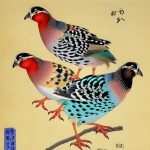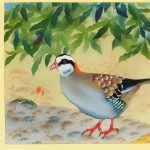Japanese quail, also known as Coturnix quail, are small birds that are popular for their egg and meat production. They are native to East Asia and have been domesticated for thousands of years. There are several different breeds of Japanese quail, each with its own unique characteristics and qualities. These breeds vary in size, color, and productivity, making them suitable for different purposes such as egg or meat production. Japanese quail are relatively easy to care for and can be raised in small spaces, making them an ideal choice for backyard farmers and commercial producers alike. In this article, we will explore the characteristics of different Japanese quail breeds, popular breeds for egg and meat production, as well as rare and exotic breeds. We will also discuss how to select the right breed for your specific needs and provide tips for breeding and caring for Japanese quail of different breeds.
Key Takeaways
- Japanese quail breeds are known for their small size, fast growth, and high egg production, making them popular for both meat and egg production.
- Different Japanese quail breeds have distinct characteristics such as color, size, and egg production, with some being more suitable for meat production and others for egg production.
- Popular Japanese quail breeds for egg production include the Pharaoh, Tuxedo, and Golden Manchurian, known for their high egg-laying capabilities and adaptability to various environments.
- Japanese quail breeds for meat production include the Jumbo Brown and Italian, known for their fast growth, large size, and high meat-to-bone ratio.
- Rare and exotic Japanese quail breeds such as the Tibetan and White Bobwhite are sought after for their unique appearances and characteristics, making them popular among enthusiasts and collectors.
Characteristics of Different Japanese Quail Breeds
There are several different breeds of Japanese quail, each with its own unique characteristics. The most common breeds include the Pharaoh, Italian, Tuxedo, and Tibetan quail. The Pharaoh quail is the most widely raised breed and is known for its high egg production. It has a brown and white speckled plumage and is relatively docile in nature. The Italian quail, on the other hand, is smaller in size and has a more delicate appearance with a light brown plumage. The Tuxedo quail is named for its distinctive black and white plumage, making it a popular choice for ornamental purposes. The Tibetan quail is known for its hardiness and ability to thrive in a variety of climates. It has a unique mottled plumage with shades of brown and black.
Each breed also has its own unique egg production capabilities, with some breeds laying more eggs than others. The Pharaoh quail, for example, is known for its high egg production, making it a popular choice for commercial egg producers. The Italian quail also lays a good number of eggs, although slightly smaller in size compared to the Pharaoh quail. The Tuxedo and Tibetan quail breeds are less commonly used for egg production but are valued for their ornamental qualities and adaptability to different environments. In terms of temperament, some breeds may be more docile and easier to handle, while others may be more skittish and flighty. Understanding the characteristics of different Japanese quail breeds is important when selecting the right breed for your specific needs.
Popular Japanese Quail Breeds for Egg Production
When it comes to egg production, the Pharaoh quail is the most popular breed among Japanese quail. This breed is known for its high egg production, with hens laying an average of 300 eggs per year. The eggs are small in size but are prized for their rich flavor and nutritional value. The Pharaoh quail is also relatively easy to care for and can adapt well to different environments, making it a popular choice for both backyard farmers and commercial egg producers. Another popular breed for egg production is the Italian quail. While slightly smaller in size compared to the Pharaoh quail, the Italian quail is also known for its good egg production, with hens laying an average of 280 eggs per year. These eggs are also small in size but are highly nutritious and have a delicate flavor.
Both the Pharaoh and Italian quail breeds are relatively docile in nature, making them easier to handle and manage compared to other breeds. They are also known for their fast growth rate, reaching maturity at around 6-8 weeks of age. This makes them an ideal choice for those looking to start a quail egg production business. In addition to their high egg production capabilities, these breeds are also valued for their meat production qualities. When hens reach the end of their egg-laying cycle, they can be processed for meat, making them a dual-purpose breed. Overall, the Pharaoh and Italian quail breeds are popular choices for those looking to raise Japanese quail for egg production due to their high productivity, adaptability, and dual-purpose qualities.
Japanese Quail Breeds for Meat Production
While all Japanese quail breeds can be used for meat production, some breeds are specifically bred for their meat qualities. The Jumbo or Giant quail breed is one such example. As the name suggests, this breed is larger in size compared to other Japanese quail breeds, making it a popular choice for meat production. Jumbo quails can reach weights of up to 12-14 ounces within 6-8 weeks, making them an ideal choice for those looking to raise quail primarily for meat. Their meat is tender and flavorful, with a higher meat-to-bone ratio compared to other breeds.
Another popular breed for meat production is the English White quail. This breed is known for its fast growth rate and high feed conversion efficiency, making it a cost-effective choice for meat production. English White quails can reach weights of up to 10-12 ounces within 6-8 weeks and have a good meat-to-bone ratio. Their meat is tender and succulent, making them a popular choice among consumers. In addition to their meat production qualities, both the Jumbo and English White quail breeds are relatively easy to care for and can adapt well to different environments.
When raising Japanese quail for meat production, it’s important to consider factors such as growth rate, feed conversion efficiency, and meat-to-bone ratio when selecting a breed. The Jumbo and English White quail breeds are popular choices due to their fast growth rate, high meat-to-bone ratio, and overall meat quality. These breeds are well-suited for commercial meat production as well as backyard farming.
Rare and Exotic Japanese Quail Breeds
In addition to the more common Japanese quail breeds such as the Pharaoh, Italian, Tuxedo, and Tibetan quails, there are also rare and exotic breeds that are prized for their unique characteristics and ornamental qualities. One such breed is the Golden Manchurian quail, which is known for its striking golden plumage and ornamental value. This breed is relatively rare and is sought after by collectors and enthusiasts for its unique appearance.
Another rare breed is the Silver Range quail, which has a distinctive silver plumage with black markings. This breed is prized for its ornamental qualities and is often raised for exhibition purposes. The Silver Range quail is relatively rare and may be harder to find compared to more common breeds.
The Rosetta or Rosetta Red quail is another exotic breed that is prized for its unique coloration. This breed has a reddish-brown plumage with white markings, making it a popular choice among collectors and enthusiasts.
Rare and exotic Japanese quail breeds are often raised for ornamental purposes rather than for egg or meat production. They are valued for their unique appearance and may be harder to find compared to more common breeds. Collectors and enthusiasts may seek out rare and exotic breeds to add diversity to their flocks or for exhibition purposes.
Selecting the Right Japanese Quail Breed for Your Needs

When selecting a Japanese quail breed, it’s important to consider your specific needs and goals. If you’re primarily interested in egg production, then breeds such as the Pharaoh or Italian quails may be the best choice due to their high egg production capabilities. These breeds are also valued for their dual-purpose qualities, as they can be processed for meat once they reach the end of their egg-laying cycle.
For those looking to raise Japanese quail primarily for meat production, breeds such as the Jumbo or English White quails may be more suitable due to their larger size and superior meat qualities. These breeds are specifically bred for their meat production capabilities and are well-suited for commercial meat production as well as backyard farming.
If you’re interested in rare and exotic breeds for ornamental purposes or exhibition, then breeds such as the Golden Manchurian, Silver Range, or Rosetta Red quails may be worth considering. These breeds are prized for their unique appearance and ornamental value.
It’s also important to consider factors such as temperament, adaptability to different environments, and ease of care when selecting a breed. Some breeds may be more docile and easier to handle, while others may be more skittish or flighty. Understanding the characteristics of different Japanese quail breeds will help you make an informed decision based on your specific needs and goals.
Breeding and Caring for Japanese Quail of Different Breeds
Once you’ve selected a Japanese quail breed that suits your needs, it’s important to understand how to properly care for and breed these birds. Japanese quails are relatively easy to care for and can be raised in small spaces such as backyard pens or commercial facilities.
When breeding Japanese quails, it’s important to provide them with a suitable environment that meets their specific needs. This includes providing proper housing with adequate space, ventilation, and protection from predators. Quails also require a balanced diet that includes high-quality feed, fresh water, and access to grit for digestion.
When caring for Japanese quails of different breeds, it’s important to consider factors such as temperature control, lighting, and disease prevention. Quails are sensitive to temperature extremes and require proper ventilation and insulation to maintain optimal conditions. Providing adequate lighting is also important for stimulating egg production in hens.
In terms of disease prevention, it’s important to practice good biosecurity measures to prevent the spread of diseases within your flock. This includes regular cleaning and disinfection of housing facilities, monitoring the health of your birds, and practicing proper quarantine procedures when introducing new birds into your flock.
Breeding Japanese quails requires careful management of breeding pairs or groups to ensure genetic diversity and healthy offspring. It’s important to monitor breeding pairs or groups closely to ensure successful mating and egg production.
Overall, breeding and caring for Japanese quails of different breeds requires attention to detail and proper management practices to ensure the health and productivity of your flock. By understanding the specific needs of different breeds and implementing proper care and breeding practices, you can successfully raise Japanese quails for egg or meat production as well as ornamental purposes.
It is important to provide a suitable environment, balanced nutrition, and regular health checks for the quails. Additionally, understanding the behavior and social dynamics of the different breeds can help in creating a harmonious flock. By being attentive to their needs and providing a well-managed environment, you can ensure the overall well-being and success of your Japanese quail breeding operation. Whether you are raising them for commercial purposes or as a hobby, proper care and management are essential for the overall success of your quail breeding endeavors.
If you’re interested in learning more about Japanese quail breeds, you might also want to explore an article on the importance of providing a coop for turkeys. Understanding the housing needs of different poultry species, such as turkeys, can provide valuable insights into creating suitable environments for Japanese quail as well. Check out the article “Do Turkeys Need a Coop?” for more information on this topic.
FAQs
What are the different breeds of Japanese quail?
There are several different breeds of Japanese quail, including the Jumbo Brown, Italian, Tuxedo, English White, and Golden Manchurian.
What are the characteristics of the Jumbo Brown Japanese quail breed?
The Jumbo Brown Japanese quail breed is known for its large size and rapid growth. It is a popular choice for meat production.
What are the characteristics of the Italian Japanese quail breed?
The Italian Japanese quail breed is known for its distinctive coloring, with a combination of brown, black, and white feathers. It is also valued for its high egg production.
What are the characteristics of the Tuxedo Japanese quail breed?
The Tuxedo Japanese quail breed is named for its striking black and white coloring, resembling a tuxedo. It is popular for both meat and egg production.
What are the characteristics of the English White Japanese quail breed?
The English White Japanese quail breed is known for its pure white feathers and is valued for its high egg production.
What are the characteristics of the Golden Manchurian Japanese quail breed?
The Golden Manchurian Japanese quail breed is known for its golden-colored feathers and is popular for both meat and egg production.
Meet Walter, the feathered-friend fanatic of Florida! Nestled in the sunshine state, Walter struts through life with his feathered companions, clucking his way to happiness. With a coop that’s fancier than a five-star hotel, he’s the Don Juan of the chicken world. When he’s not teaching his hens to do the cha-cha, you’ll find him in a heated debate with his prized rooster, Sir Clucks-a-Lot. Walter’s poultry passion is no yolk; he’s the sunny-side-up guy you never knew you needed in your flock of friends!







